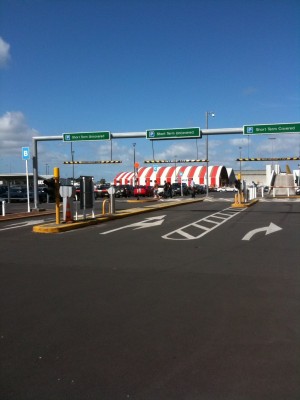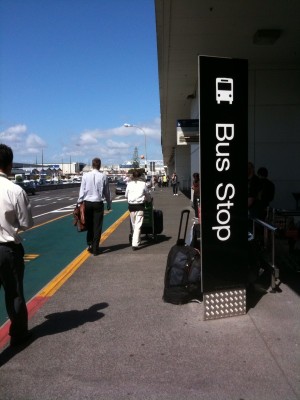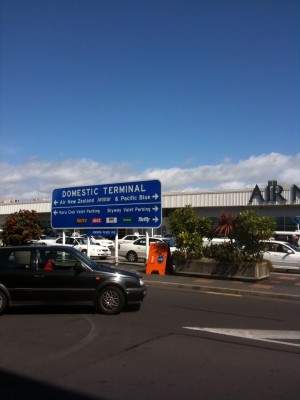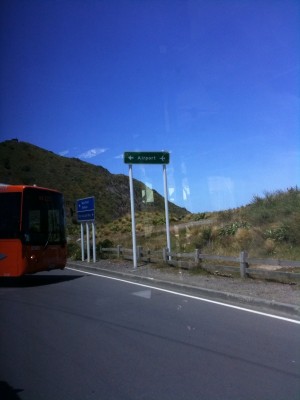Auckland Airport Wants Airport Rail Link Sooner
Auckland Airport is calling today for an airport rail link to be hurried up.
The company does so in the company’s submission to the ARC on its draft regional transport strategy, in which it calls for better public transport services to the airport.
And Auckland Airport calls public transport connections to the Airport currently “weak by international comparisons and as a consequence patronage is low.” The company’s submission says it’s concerned that the ARC’s strategy offers “very little improvement to Airport users in terms of public transport until rail is delivered sometime after 2030”.
The ARC’s draft RLTS had proposed an airport rail connection in the 2031-40 time frame but Auckland Airport says plans for a Rapid Transit Network link to the Airport, whether rail or some intermediate step, should be accelerated and ideally put in place prior to 2020.
The company’s submission says in the short term, public transport services should be upgraded to Quality Transit Network (“QTN”) standards (such as dedicated bus lanes) to provide an appropriate connection to the Airport from both the CBD and the North Shore.

Auckland Airport carpark
The submission also points out there’s no commitment in the RLTS to creating a direct connection to the CBD and other centres for both QTN and private transport.
For the foreseeable future, the main CBD route will still be via the suburbs of Royal Oak and Epsom “this is fundamentally incompatible with the character of those suburbs which are predominantly residential and have a very high concentration of schools.”

Auckland Airport bus connections are called "weak"
Although improvements are being made to Airport Express bus services, “service quality is hampered by wide variances in travel times due to traffic congestion.”
The submission notes the overall intention of the RLTS is to invest in public transport services ahead of demand. But there is no significant short-to-medium-term investment planned to ensure that the Airport has reliable public transport connections to the region that will be attractive enough to incentivise greater use.
“Public transport connections to the Airport are already insufficient to meet existing demand and therefore require significant investment by transport authorities to bridge the existing gap before capacity for future growth can be provided.”

Domestic terminal has heavy car traffic
The airport’s main criticisms - besides rail - are summarised:
- There’s no commitment to creating a direct connection to the CBD and other centres for both QTN and private transport. There’s currently no established highway connection from the Airport to the CBD (for private vehicles, taxis and shuttles). Although an interim step of a Clear Route is soon to be implemented, that will not be on the Regional Strategic Network but will be via the suburbs of Royal Oak and Epsom. This is fundamentally incompatible with the character of those suburbs which are predominantly residential and have a very high concentration of schools.
- Although an RTN is planned, delivery is not anticipated before 2030 at the earliest, we believe this is too far in the future, particularly if an extensive QTN connection to the Airport is not provided in the shorter term. There is currently no RTN route designated or protected. Auckland Airport is committed to facilitating an RTN through Airport land but is concerned that no detailed planning or design work has been undertaken on the route beyond the Airport boundary. This is not only putting the route of an RTN to the Airport in jeopardy, but presents challenges for the Airport masterplanning, as development within the Airport district continues without a clear understanding of the RTN requirements. That comment applies also to planning adjacent to the Airport district in Airport Oaks and the eastern approaches to the Airport.
- The proposed upgrades of SH20A & SH20B are very necessary and welcome. They will however increase non-airport related traffic travelling through the Airport, including heavy goods traffic, and there should be provision to deal with that traffic. It is already clear that there has been a significant increase in traffic through the Airport on a road network that has not been designed to accommodate it.

Wellington airport has just an airport bus service
So it wants the strategy changed accordingly to reflect the following:
- Until Auckland Airport is connected to a region wide RTN, ensure as a matter of priority that it is adequately connected to a region wide QTN, and that this QTN provides an appropriate connection to the Airport from both the CBD and the North Shore for both travelers and airport workers.
Any public transport service to Auckland Airport needs to recognize that the Airport is a 24/7 operation and that airline passengers are absolutely time sensitive. Accepting that the Airport will be served by just the QTN in the short term, service levels for Airport public transport need to be adjusted to reflect both the 24/7 nature of the Airport and to recognise that air travellers need certainty over journey time for public transport.
It is difficult to see how the required service levels for Airport services can be achieved if the relevant QTN services do not run on priority lanes. Auckland Airport is aware of proposals (but no date for delivery) to upgrade Dominion Road to that standard but the connections of the northern end of Dominion Road to both the CBD and the Regional Strategic Network (from the North Shore) seem very uncertain. Those connections need to be addressed as a matter of urgency.
- Give greater priority to the proposed South Western Corridor to East Tamaki link to provide a more direct and unencumbered arterial connection to the Airport from the CBD and the North Shore.
We note under Policy 6.2.2 that the South Western Corridor to East Tamaki link is identified as an Activity of High Regional Significance but only to the extent of planning, protecting and identifying funding.
This suggests to us that there is no plan to have the link operational within the 30 year life of the proposed 2010 Strategy. That is an unacceptable time for the region to have to wait for a direct unencumbered Regional Strategic Network link to the Airport from the North Shore and the CBD.
- As part of improved SH 20A/20B access to the Airport, provide better connectivity between 20A and 20B to ensure that traffic transiting the Airport district does not impede traffic servicing or accessing airport facilities.
- Confirm as a matter of first priority the alignment of the proposed airport rail link immediately outside the Airport district, so that Auckland Airport can make appropriate provision in the Airport Masterplan.
There needs to be more certainty in the RLTS as to when those matters would be determined. In our view they need to be determined within the next two years, as we note that the determined alignment will also impact on off-airport infrastructure like the proposed Kirkbride grade separation.
- Provide a RTN link to the Airport (whether that is rail or some intermediate step) on an accelerated basis (ideally, prior to 2020), rather than between 2031-40 as currently proposed.











11 Comments
Seeing as it is so important to them I suppose the airport company would be willing to help pay for a good portion of the cost requried to build it then.
Thought not,
This good news, it makes the intention clear and as it is a large business might get support from the C & R and central government…
Unbelievable!
This from a company that has always protested that PT, and in particular rail, will abstract from it’s parking revenue!
Well done AIAL for the change in heart!
It’s good to see that they have a real understanding of what is important - however I would expect they might fund the connection within their land including the airport station, if ARTA approach the deal in the right way, which although small, will indeed help a little.
How about a Northern Express service that runs to the airport, as well as a New Lynn to airport service. These also need to connect to the airport industrial areas somehow as well so workers could use the service as well, which would make it more viable.
The airport express certainly is too expensive to be used by workers. Maybe when ‘Thales-card’ comes into use, users with this card will be charged normal PT zone rates, and tourists will be charged the full $16.
Dear God why does this have to be so complicated?
All that is required is a 2-stage or 3-stage plan, i.e:
Stage 1:
Ditch C&R’s silly “clearways” proposal for the Manukau Road/Pah Road corridor. These will only turn a pleasantish route into yet another ghastly 4-laned road. “Clearways” reserve scarce road space for yet more cars, induce demand, and do nothing to future-proof the corridor against the projected doubling of the population over the next 30-odd years.
Instead create 24/7 bus lanes (leading into a widened Queenstown Rd if necessary). This would leverage the investment in the Northern Busway and Central Connector.
Run fast and frequent QTN services from Albany Station to the airport, stopping at the busway and Central Connector stations and also at Newmarket (ideally adjacent to the station), Greenwoods Corner and somewhere near Onehunga.
Allow anyone to use the service, not just airport-bound passengers. This increases viability and provides an “express” option for North Shore to University, the hospital and Newmarket, and for punters in the Epsom and western Onehunga areas.
I can imagine this being so successful it will end up running 5-minute peak frequencies in short order.
Stage 2:
As and when the Dominion Rd corridor is developed with its dedicated bus bypasses running around the back of the Eden Valley and Balmoral shops (completion around 2016), develop a supplementary QTN route CBD-Airport.
Stage 3:
Rail - obviously a long way off, but do-able in part from next year with dedicated connections at Onehunga Station.
What is the information on the proposed rail line along SH20?
Would it connect to Onehunga or Airport or Both?
Plans in the future are for a connection to Manukau and a connection back to Onehunga.
This is quite a turnaround for the airport as until recently they actively opposed better PT connections.
I agree with Chris R’s comment, this is a major change of policy. Good on them.
What we have to watch out for (it’s a while yet, sadly) is that the AIAL don’t gouge rail passengers. They need to be told that an airport is just one more station, regular fares must be charged.Any “special surcharge” for airport passengers would mean the AIAL are up to their old tricks again!
As I am unfamiliar with AKL city and suburbs it’s difficult for me to comment here but so long as they don’t to it like Cardiff (UK). If you don’t know - it’s a station for the village of Rhoose located on the other side of the airport. As a station for the village it is badly designed but OK for travellers into Cardiff (as it reopened a train line disused for years) but to call it Rhoose/Cardiff International is hilarious and sad at the same time. On top of that passengers have to connect to a mini-bus!! To say it should never have gotten the go-ahead is an understatement! Anyways, I’d say that yes AKL needs the airport link. I’m not sure how best to go about it route-wise but it would benefit further the status of AKL is a world city amid its growing reputation in world rankings. I just can’t believe Britomart (which I’ve never seen in person) will be at capacity by 2016!
An airport-rail link is more likely to increase revenue due to the amount of people who are more inclined to use that airport rather than another, because it may work out cheaper for them overall.